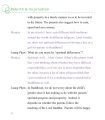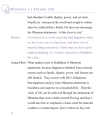non-thinking : ค้นหาหนังสือธรรมะ หน้า 5 / 16
หน้าหนังสือทั้งหมด

72
Velama Sutta: The Power of Good Will
The Voice of Abstaining
7. Velama Sutta
“If one were to develop even just one whiff of a heart of good will, that would be more fruitful than... if one with a confident mind were to undertake the tra
This text discusses the teachings of the Velama Sutta, emphasizing that developing even a small amount of good will is more fruitful than significant material offerings and merits. It illustrates how

92
The Victory of Abandoning: Insights from the Dana Sutta
The Victory of Abandoning
9. Dana Sutta
Those 6 things Then, having exhausted that action, that
power, that status, that sovereignty, he is a returner,
coming back to this world.
7. "-- but with the
The Dana Sutta presents profound insights on the nature of giving and its consequences in the spiritual journey. It describes how the mindset behind acts of generosity can influence their outcomes—whe

113
Discovering Inner Transcendental Bodies
He further discovered that when the mind is relaxed in a standstill state, while resting at the center of the Dhamma Sphere, inner transcendental bodies will emerge, one after another: from coarse hum
This text discusses the emergence of inner transcendental bodies through relaxation at the center of the Dhamma Sphere. As the mind achieves a state of calm and stillness, one can transition through v

156
Glossary of Important Terms in Enlightenment
Glossary
Arahant – Someone who has attained enlightenment (or no longer has defilement). This person is free from greed, delusion, ignorance and such things as that.
Baap – The bad stuff that’s floa
This glossary provides definitions of essential terms in the context of enlightenment and mindfulness practices. It discusses concepts such as Arahant, individuals who have achieved enlightenment free

20
The Origins and Impact of the Dhammakaya Foundation
The Dhammakaya Foundation itself was established on 20 February 1970. Buildings were kept to a minimum and emphasized finesse, easy maintenance, cleanliness and durability. The foundation stone for th
The Dhammakaya Foundation was established on 20 February 1970 with a focus on minimalistic yet durable structures for spiritual practice. H.R.H. Princess Maha Chakri Sirindhorn provided the foundation

29
Activities of the Dhammakaya Foundation
RECONDITION
CTIVITIES OF THE DHAMMAKAYA FOUNDATION
Realizing that irrespective of age or walk of life, no person is in any less need than the next for the means by which to raise the quality of his
The Dhammakaya Foundation engages individuals from all walks of life to enhance their mental quality through a variety of year-round activities. These include meditation training, educational initiati

43
National Dhamma Quiz Contest
The text in the image is:
"National Dhamma Quiz Contest
The Dhamamkaya Foundation in co-operation with the International Buddhist Club have arranged a yearly peace and ethics education curriculum wh
The Dhamamkaya Foundation, with the International Buddhist Club, organizes a yearly peace and ethics education curriculum that features a quiz contest for schoolchildren, university students, and mili

69
Success of Moral Training Projects: Dhammadayada Program
ASE HISTORY OF THE SUCCESS OF MORAL TRAINING PROJECTS
The Dnammadayada (Dhamma Inheritors) Training Programme has been conducted for twenty-seven years since the beginning of the Dhammikaya Foundatio
The Dhammadayada Training Programme has operated for twenty-seven years, focusing on hands-on Buddhist practice for students. In 1996, the program was scientifically assessed, revealing that participa

19
Understanding Buddhism: Key Concepts and Texts
death
chronicle
position
awake with awareness
awake in the sea of merit
fire contemplation; fire as meditation device
shrine; altar; group of tables containing images of Buddha
triple robe; the three
This text delves into crucial Buddhist principles including the Tipitaka, which is a comprehensive scripture forming the foundation of Buddhist teachings. It encompasses three baskets: Vinaya Pitaka,

64
ศัพท์และคำจำกัดความในพระพุทธศาสนา
อเวจี the lowest hell
อสงไขย eternal length of time; eons; eternity; infinity
อสูักะ a corpse
อิงสงสาร non-violence
อิโหสิกรรม forgiven Kamma
อัครสาวก chief disciple
อังคุตตรนาคาย (Anguttaranikaya) Nu
เนื้อหาประกอบด้วยศัพท์และคำจำกัดความในพระพุทธศาสนา เช่น อเวจี (the lowest hell) หมายถึงนรกที่ต่ำที่สุด, อสงไขย (eternity) แสดงถึงระยะเวลายาวนาน, อัตตา (atta) ซึ่งหมายถึงตัวตนหรืออีโก้ของบุคคล นอกจากนี

114
Understanding Dispassion and Detachment in Dhammakaya Meditation
dispassion (ekantanibbida) and detachment (viraga) and accomplishes sequential shedding of the defilements until an end to defilements can be reached.
The meditator sees and knows with the latter fou
This text delves into the significance of dispassion (ekantanibbida) and detachment (viraga) in the process of shedding defilements through meditation. It illustrates the attainment levels based on th

6
Clear-minded Youths: The Dhamma for Teenagers
Preface
Clear-minded Youths (The Dhamma for teenagers) has 6 stories about Buddhist children in Lord Buddha Period. There are Buddhist and non-Buddhist children.
For studied about how to build the r
Clear-minded Youths (The Dhamma for teenagers) presents six engaging stories about Buddhist and non-Buddhist children from the Lord Buddha's era. The book aims to cultivate religious faith among child

16
การปฏิเสธในตรรกศาสตร์และนิรวาณ
การปฏิเสธโดยไม่มีความหมายเชิงยืนยันในสิ่งที่ตรงข้าม ส่วน "non ~ P " คือปรโยทัละติซซึ่งเป็นการปฏิเสธโดยมีความหมายเชิงยืนยันในสิ่งที่ตรงกันข้าม เมื่อเป็นดังนี้กฎฎฤษฎะจึงยืนยันว่า X is neither P nor non
บทความนี้อธิบายเกี่ยวกับการปฏิเสธในตรรกศาสตร์ โดยนำเสนอแนวคิดเกี่ยวกับนิรวาณว่าเป็นสิ่งที่เกิดและดับ พร้อมตัวอย่างการใช้กฎฎฤษฎะในตรรกศาสตร์ซึ่งมีความหมายเชิง противоположности. การปฏิเสธประเภทต่าง ๆ ถ

62
Peace Revolution 2010
900
Peace Revolution since 2010)
+ http://www.peacerevolution2010.org/
Coogle
ETERANS Car vessters
welcome here
WAR NO MORE
How can I use inner peace
to confront destructive thinking?
The World is Cha
โครงการ Peace Revolution 2010 เป็นโครงการสำหรับเยาวชนทั่วโลกจากทุกชาติ ทุกศาสนา ที่มาร่วมบันทึกความดีออนไลน์ผ่านบทฝึก 42 วัน เพื่อสร้างนิสัยในการพัฒนาตนเองตามแนวทางของพระสัมมาสัมพุทธเจ้า โดยสามารถเข้า

11
The Importance of Love and Discipline in Relationships
This sacred union also serves as the path for the birth
of virtuous people into this world to pursue
Perfections.
Since we exist in a world dominated by sensual
pleasures, it is essential for us to re
การมีความรักก่อนความปรารถนาเป็นสิ่งสำคัญในการสร้างครอบครัวที่มีคุณค่า พ่อและแม่มีบทบาทสำคัญในการสอนลูกให้มีระเบียบวินัยและเคารพกฎแห่งกรรม เพื่อหลีกเลี่ยงพฤติกรรมที่นำไปสู่ผลเสียในชีวิต พฤติกรรมที่ขาดร

32
Living a Celibate Life and the Journey to Nibbana
choose to live celibate lives. One solution is to select
specific dates to observe The Eight Precepts which
prohibits any sexual relationship, such as on Buddhist
Holy days or on birthdays. This compr
This text discusses the choice of living a celibate life within Buddhism, highlighting how observing The Eight Precepts on certain dates enables individuals to meet their spiritual obligations. It ref

20
Rebirth & Incarnation in Buddhism
Rebirth & Incarnation
Monica
with property in a timely manner so as to be invested
in the future. The parents also suggest how to earn,
spend and save money.
: In my travels I have seen different birt
In Buddhism, the gender of a child is not considered important for the spiritual progress of parents. Conversations highlight that responsibilities are not tied to the sex of the child, emphasizing th

24
Monastic vs Secular Life: Insights on Dhamma
Monastic v.s Secular Life
Monica
had abundant wealth, dignity, power, and servants.
Finally, he renounced the world and sought to ordain
since he realized that a family life does not encourage
the Dha
In this discussion, the speaker reflects on the differences between monastic and secular lifestyles, emphasizing the pursuit of Dhamma as the true source of happiness, in contrast to material possessi

17
Endurance Against Defilements: Building a Stable Family
squeezes us, controls us and wears us down to perform all
kinds of bad deeds shamelessly. Then when we perform the
bad deed, defilements let us suffer, receive punishments,
experience all kinds of dis
This text discusses the impact of defilements on individuals and families, emphasizing how these negative influences lead to bad habits and a breakdown of unity within families. It identifies the 'Roa

37
The Four Universal Forms of Benevolence
The Buddha answered this question in one word:
benevolence. That is to say mutual benevolence, the practice
the Four Universal Forms of Benevolence (Sangahavatthu),
promote happiness in living togethe
This text discusses the Buddha's concept of mutual benevolence as the foundation for happiness in relationships. It outlines the Four Universal Forms of Benevolence: Giving, Pleasant Speech, Mutual Be
